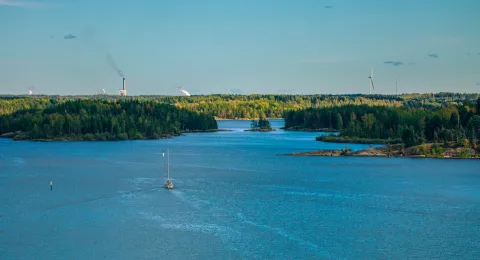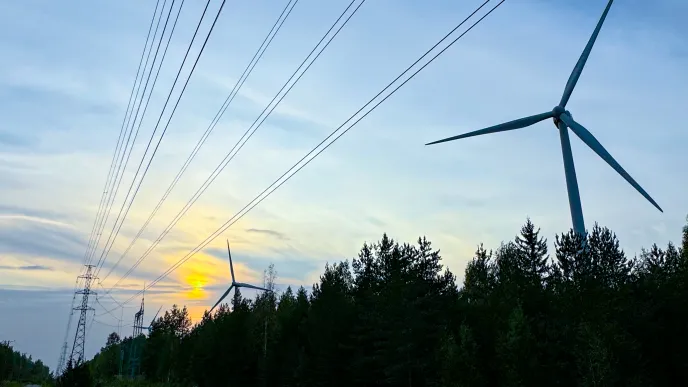The fight against climate change has a clear goal: human-generated greenhouse gas emissions and the carbon sinks that bind them must strike a balance. Europe has sought related solutions by means of climate policy regulation. Finland’s ambitious target is to achieve carbon-neutrality by 2035.
The most important measure to reduce greenhouse gas emissions is to eliminate fossil fuels and raw materials in energy production, industry, heating, and transportation. Energy production must shift to emission-free forms, which Finland has mainly done already.
For industry, heating, and transportation, the solution is electrification: direct electrification whenever possible, and so-called indirect electrification with hydrogen whenever it is not. In transportation, the answer is electric vehicles. In heating, electricity should be used increasingly in heat pumps and in electric boilers of district heating systems. Industry holds great potential for direct electrification. Indirect electrification based on hydrogen, on the other hand, can be implemented in the maritime and aviation industries in the form of new fuels, new emission-free chemicals, and emission-free steel.
Electrification is a good fit for Finland – a country that has long relied heavily on electricity. We have a strong grid and excellent electricity supply security.
New industrialisation requires a significant amount of electricity
Finland has a golden opportunity to create new industry to solve the world’s emission problems. The battery industry and green steel have extensive export potential. Products processed from green hydrogen, such as fossil-free fertilizers and synthetic fuels for the maritime and aviation industries, are a growing industry with great demand. In the chemical industry, bio-based carbon dioxide from the forest industry provides Finland a special competitive edge.
New industrialisation demands a significant amount of additional electricity. If Finnish industry succeeds in the green transition, the current electricity consumption in Finland will multiply. However, a particular form of electricity is required for that purpose: it must be emission-free and low-cost, and its supply must be secure. Finland’s starting point is excellent, because the additional need for electricity can be met with highly competitive onshore wind energy. In Europe, potential areas for low-cost electricity production include Finland, the other Nordic countries, and the Iberian Peninsula. Finland’s wind and solar power potential will be enormous once we learn how to take advantage of the fluctuating wind power generation.
Research shows that transporting electricity or hydrogen thousands of kilometres is not economically viable. Hydrogen production and new industrial investments should be located near low-cost electricity production. In other words, Finland should not specialise in the export of products with a low degree of processing (electricity or hydrogen). The export of hydrogen is always a possibility, but the ultimate goal is to process it as far as possible in Finland. On the other hand, the export of chemicals, plastics, and fuels is straightforward, and the related logistics already exist.
Success requires new leadership
Even though Finland’s starting point for the green transition is excellent, success in it requires hard work. Finland’s success is achieved in the context of the European Union, which provides regulation that creates the market and foundation for green investments. Regulation by the European Union should be seen as an opportunity rather than a threat. It requires a clear vision of the future and strong European influencing from us. All this should be included in Finland’s industrial strategy. Finland needs a distinct shift from reactivity to proactivity and solutions to European-level problems to make European regulation function also in Finland’s favour.
So far, regulation by the European Union has been nearly exclusively climate-focused, lacking the dimensions of economic well-being and security. Partly for this reason, regulation has been quite detailed and has ignored the regional differences and competitive advantages of individual member states. In the future, regulation should concentrate on shared goals and let member states find their own ways of achieving them. Individual countries should not be left alone to shoulder unreasonable responsibilities (e.g., carbon sinks). Instead, goals should be set for a wider scope.
Going forward, the strategies of the European Union and Finland should avoid silos and emphasise a balance between three dimensions: economic well-being, climate, and security. That would also eliminate unnecessary micromanagement. Nevertheless, the approach requires a new type of thinking and closer collaboration between decision-makers in different areas.
Finland’s strategic targets
- Economic well-being: New growth and well-being in Finland will be based on renewable electricity and new, clean, internationally competitive industry based on it.
- Setting a climate example: Finland will be carbon neutral by 2035.
- Energy security: Finland will, like the other Nordic countries, tap into its potential for the sustainable production of critical raw material and renewable electricity, which are needed in the green transition.
The green transition is a new source of well-being
Implementing the green transition in a balanced manner enhances its social acceptability: citizens must see that the change works in their favour. The green transition is a new source of well-being, meaning improvement in economic well-being, the environment, and security.
Finland’s next industrial step is to invest billions of euros in the manufacture of green products: steel, methanol, ammonia, plastics, adhesives, and solvents. This will lead to a growing demand for electricity, which can be met by investing in low-cost, renewable electricity generation, seizing Finland’s competitive edge. The transfer of electricity and hydrogen requires billions of euros worth of investments in electrical power and hydrogen networks. A functional infrastructure will constitute Finland’s competitive edge in the future. Moreover, significant investments in logistics are needed.
In addition to the manufacture of green products, Finnish technology companies are facing opportunities related to the development and production of new green technology for which a global market is opening up. Demonstrations in the domestic markets are important when technology is being developed for export.
Emission-free, low-cost, and secure electricity will attract investments into Finland. Nevertheless, international competition is intense. Success stories demand wise choices and hard work. Finding solutions means looking into the future – not the past. Academic research combined with efforts by a range of societal actors helps open and define future perspectives.
More information







